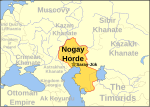 | The Pontic–Caspian Steppe is a steppe extending across Eastern Europe to Central Asia, formed by the Caspian and Pontic steppes. It stretches from the... 15 KB (1,208 words) - 19:12, 19 April 2024 |
 | northeast of the Caspian Sea, forming the Ural-Caspian Narrowing, that joins the Pontic-Caspian Steppe in Europe with the Kazakh Steppe in Central Asia... 35 KB (3,907 words) - 01:36, 27 April 2024 |
 | Kurgan hypothesis (redirect from Steppe hypothesis) model, by the early 3rd millennium BC had expanded throughout the Pontic–Caspian steppe and into Eastern Europe. Recent genetics studies of late 2000s,... 34 KB (3,825 words) - 14:41, 30 April 2024 |
 | region between the Southern Bug, Dniester, and Ural rivers (the Pontic–Caspian steppe), dating to 3300–2600 BCE. It was discovered by Vasily Gorodtsov... 67 KB (6,937 words) - 08:30, 30 April 2024 |
Scythia (section Arrival in the Pontic steppe) also known as Pontic Scythia, was a kingdom created by the Scythians during the 6th to 3rd centuries BC in the Pontic–Caspian steppe. The names Scythia... 29 KB (3,583 words) - 04:29, 8 April 2024 |
 | Pontic–Caspian steppe and west of the Emin Valley steppe, with which it forms the central and western part of the Eurasian steppe. The Kazakh Steppe is... 10 KB (787 words) - 02:41, 31 October 2023 |
 | the eastern Pontic-Caspian steppe around 5,000 BC, while admixture with EEFs happened in the southern parts of the Pontic-Caspian steppe sometime later... 72 KB (8,246 words) - 02:16, 1 May 2024 |
 | Pontic–Caspian steppe area is often also encompassed under the notion of a Ciscaucasus region, thus the northern boundary of the Forecaucasus steppe or... 19 KB (1,557 words) - 12:43, 28 April 2024 |
 | Maykop culture (section Pontic–Caspian steppe) American ancestry as the f4-statistics (Steppe_Maykop, Fitted Steppe_Maykop; Outgroup1, Outgroup2) show that the Steppe Maykop individuals share more alleles... 22 KB (2,637 words) - 10:03, 11 April 2024 |
southern shores The Pontic–Caspian steppe, steppelands stretching from north of the Black Sea as far east as the Caspian Sea The Pontic Mountains, a range... 2 KB (230 words) - 12:39, 25 August 2021 |
 | were Turkic semi-nomadic warrior tribes that flourished in the Pontic–Caspian steppe and the Volga region during the 5th-7th century. They became known... 108 KB (11,936 words) - 00:47, 28 April 2024 |
 | The Horse, the Wheel, and Language (redirect from The Horse, the Wheel, and Language: How Bronze-Age Riders from the Eurasian Steppes Shaped the Modern World) the origins and spread of the Indo-European languages from the Pontic–Caspian steppe throughout Western Europe, Central Asia, and South Asia. He shows... 34 KB (4,484 words) - 01:18, 21 April 2024 |
 | Scythians (redirect from Scythian kingdom in the Pontic steppe) migrated during the 9th to 8th centuries BC from Central Asia to the Pontic Steppe in modern-day Ukraine and Southern Russia, where they remained established... 277 KB (32,473 words) - 16:27, 28 April 2024 |
 | Yamnaya as a consequence of a supposed "massive migration" from the Pontic-Caspian steppe, and the people of both cultures may be directly descended from... 73 KB (8,573 words) - 11:36, 28 April 2024 |
 | Late Bronze Age 1900–1200 BC culture in the eastern part of the Pontic–Caspian steppe. It is a successor of the Yamna culture, the Catacomb culture and... 16 KB (1,622 words) - 21:21, 22 March 2024 |
 | Agathyrsi (section In the Pontic Steppe) Agathyrsi in the Pontic Steppe, as well as the Cimmerians in the Caspian Steppe, and possibly the Sigynnae in the Pannonian Steppe. The archaeological... 44 KB (4,853 words) - 00:27, 31 March 2024 |
 | European forest steppe forms a transition between the Central European and Sarmatic mixed forests to the north and the Pontic–Caspian steppe to the south... 4 KB (385 words) - 20:18, 19 December 2023 |
"tribes") were Turkic nomadic equestrians who flourished in the Pontic–Caspian steppe and the Volga region between 5th and 7th century, and spoke the... 27 KB (3,153 words) - 18:49, 23 April 2024 |
 | CHG and Eastern Hunter-Gatherers in the Pontic–Caspian steppe resulted in the formation of the Western Steppe Herders (WSHs). The WSHs formed the Yamnaya... 25 KB (2,438 words) - 12:06, 1 May 2024 |








